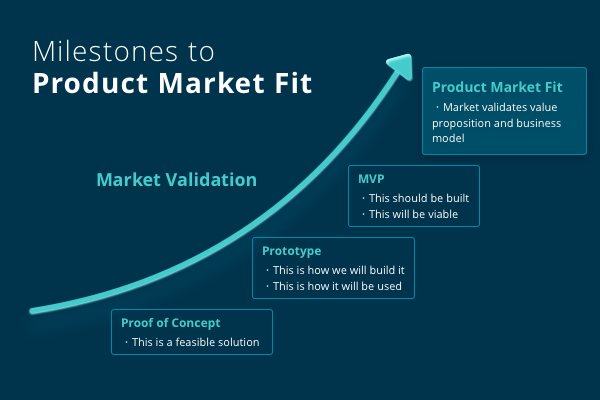In Marc Andreessen’s blog post, The Only Thing That Matters, he describes product-market fit as “being in a good market with a product that can satisfy that market.” He goes on to say that “when you are [before product-market fit], focus obsessively on getting to product-market fit.”
Thanks, Marc… now what does that mean? And what do we actually have to obsess over to get product-market fit? (To be fair, Andreessen concludes his post with an admission that his article raises more questions than it answers).
In an effort to answer some of these questions, we will explain the distinction between four key concepts:
- market validation
- proof of concept
- prototyping
- minimum viable product
Through these concepts we will show that the path to product-market fit is a process of building stronger market validation — proof of concept, building prototypes, and launching MVP are vital stages along the way.

Looking for top talent fast? See how Arc can help you:
⚡️ Find developers, designers, marketers, and more
⚡️ Freelance or full-time remote + fully vetted
⚡️ Save up to 80% with global hires
Hire top talent with Arc risk-free →
Market Validation
Andreessen is not the only one who has emphasized the importance of so-called product-market fit in determining a startup’s success or failure. Research from CBinsights supports this notion, finding that 42% of startup failures were due to a lack of market need. The lesson we can distill from this is, “don’t offer something people don’t want.”
Essentially, those failed startups did not achieve market validation.
Market validation is the way to confirm that your idea is a solution to a problem people actually have.
Some business advisors define market validation as a survey distributed to specific user segments, testing their attachment to your solution. However, we take the view that market validation is not a single action or event, but the thread that ties your whole business model together from proof of concept (POC) to product-market fit (PMF).
You don’t need a minimum viable product (MVP), or even a prototype, to start market validation. You just need an idea, open ears, and honest tongues. As soon as you have an idea you want to execute, you should talk about it!
First, you can ask friends, family, and other founders and entrepreneurs you know. Then, to the greatest extent possible, reach outside of your network to hear from people that are more likely to give it to you straight. If you get to this point, and everyone has told you it’s a stupid idea, you should probably consider the possibility that it is, indeed, a stupid idea.
If your idea is validated through your internal and external network, you should design and write a plan to continue market validation through your product development cycle. An initial step is to define your market. Who will be using your product? Whose pain point are you helping to alleviate?
Here are some basic questions to help you construct customer profiles and define your market:
- What types of companies do potential customers work for?
- How big is the company?
- What is their job title?
- How will this product improve their lives/jobs?
- How can you find them?
If you can answer these questions, you are on your way to defining your market. This will be helpful when you are ready to launch a beta and reach out to your potential users. But we’re getting ahead of ourselves! Before any testing: alpha, beta, or otherwise, you will need to prove your concept.
Read More: How to Implement a Welcoming Software Developer Onboarding Process
POC: Proof Of Concept
In software development, proof of concept is a technical exercise to demonstrate that your idea is operationally feasible. Your proof of concept (POC) will be used to garner support from internal stakeholders but will not be seen by potential customers.
The POC should use minimal time and resources, and should only verify one part within the whole system. Therefore, you might have multiple POCs to test different components of your complete solution.
An example of a POC is verifying that two technologies can talk to each other — such as a demonstration of using a mobile phone app to open a barrier. That’s it. Functionality, performance, usability, scalability, etc. are not considered within the scope of proof of concept.
In short, POC is to show that an idea can be done. It is a ‘yes’ or ‘no’ answer — if the answer is no, production will not move forward and you will go back to the drawing board. If your proof of concept is successful, you can get initial buy-in from internal stakeholders and secure financing to build prototypes. If you are a solo entrepreneur, a POC can be useful in raising initial seed-stage funding.
It is not uncommon for non-technical entrepreneurs to consult with freelance software engineers to build a proof of concept. Once the feasibility of your concept is verified, you are ready to build a prototype.
Prototype — Demonstrate the “How” of your Software Project
While the POC answers the question of whether something can be done, a prototype answers the questions of how it will be done, how it will look, and how it will be used. The prototype is a model of the system and should allow stakeholders to visualize the user experience. The model itself may or may not include functionality.
When it comes to software, a prototype usually includes the following:
- Wireframes/screens
- Product specs
- Planned features
- User flows
If you have a good prototype, your developers are more likely to deliver the product that you imagined.
Founders, designers, and engineers should all collaborate on the prototype. This will be an exercise in communication, and a test of the founder’s ability to express their idea with clarity in such a way that others can help them bring it to life. If the founder intends to raise funding, and convince customers of the value of their idea, this is an essential skill.
Wireframing tools are one method to ease the process of putting together a software prototype. A wireframe is a visual representation of a user interface intended to convey the basic concept, layout, and flow of the envisioned end product.
Not only will this help the founder better refine their idea, but it is also a means of communication among stakeholders. Wireframing tools are intuitive to use and make it easier to iterate your design as your vision becomes clearer.
It goes without saying that investors and other internal stakeholders should provide feedback on prototypes. To get stronger market validation though, you should really see what your potential customers think of your prototype. This is where a customer advisory board can come in handy.
Read More: How to Be an Engineering Manager Your Company & Team Respects
MVP: Minimum Viable Product
Early market validation answered the question “do people have this problem?” The POC proved that you can build a solution to the problem. The prototype demonstrated how you will build the solution. Now, the MVP needs to demonstrate that you should build this solution.
In the words of Eric Ries, an MVP is “the minimum set of features necessary to engage with early evangelists to start the learning feedback loop.”
The MVP stage is the time to build a minimum version of the product, and share it with a maximum number of people. The MVP needs to answer the question, “is it viable?”
The metric for this question is easy — will people buy it? If you can begin to build a user base of early adopters that are enthusiastic about your product and find it valuable enough to open up their wallets, then you know you’re onto something.
While acquiring your first paying customers is a small victory, don’t get too comfortable just yet. Unlike proof of concept, market viability is not a ‘yes’ or ‘no’ answer, and your MVP is not a final product. MVP is an ongoing process of build ⟶ measure ⟶ learn. When you make iterations based on user feedback, you enhance your value proposition and increase viability.
The iterative process of building beyond MVP is where your journey to product-market fit really begins. In a blog post entitled The Illusion of Product-Market Fit for Saas Companies, Techstars co-founder Brad Felds crassly reminds us, “You finally found someone to pay for your shitty MVP, but you’ve got a long way to go before you truly have product-market fit.”

PMF: Recognizing Product-Market Fit
What actually is product-market fit? And will you know when you get there? Let’s start by taking a look at some of the popular definitions.
A blog post by Christoph Janz defines product-market fit as “having a product that solves a problem for a significant number of independent customers.”
Founder and CEO of Reforge Brian Balfour details a product-market fit trifecta that includes non-trivial top-line growth, retention, and meaningful usage.
Josh Pigford, Founder of Baremetrics, says product-market fit “means you have a product that the market really loves and can’t do without.”
Paul Graham sums it up a bit more concisely: “Make what people want.”
According to Eric Ries’ Lean Startup Model, businesses operate on a value proposition which is essentially a hypothesis that customers will find a certain solution to a certain problem valuable. Based on this understanding of business principles, the product-market fit would be when your hypothesis is proven correct.
Read More: Understanding Remote Team Personalities Gets Your Messages Heard
Proposed Metrics for Product Market Fit
Now that we have at least a vague understanding of PMF (don’t worry, it’s a vague concept), here are some ways industry experts propose to actually measure when it is reached.
Must-have Survey
One of the most widely used methods is known as the must-have survey, designed by Sean Ellis. The survey consists of only one or two questions — the most important of which are as follows:
How would you feel if you could no longer use [the product]?
- Very disappointed
- Somewhat disappointed
- Not Disappointed
- N/A – I no longer use the product.
According to Ellis, the key indicator of PMF is 40% or more of users responding “very disappointed.” This indicates you have offered a “must-have” product to your market. In Hacking Growth by Sean Ellis and Morgan Brown, they also suggest that having a retention rate higher than that of your competitors is a sign of product-market fit.
PMF Checkpoints
Brian Balfour supplements his trifecta definition with three product-market fit checkpoints:
The Leading Indicator Survey utilizes two tests. One is Sean Ellis’s must-have survey described above. The other is the Net Promoter Score. The Net Promoter Score also relies on only one question: How likely is it that you would recommend our product to a friend or colleague? Those who answer nine or ten out of ten are considered to be promoters.
Leading Indicator Engagement Data seeks behavioral proof that people are engaging with the product in a meaningful way. This metric should go beyond just active use, but pinpoint specific actions that quantify the reason for use — such as the number of pictures shared, the number of friends added, the number of transactions processed, etc.
The Retention Curve plots the percent of active users over time. A flattening curve, (instead of the linear decline) means users are sticking around and is suggestive of product-market fit.
Monthly Recurring Revenue
In his post The Illusion of Product-Market Fit For Saas Companies, Brad Felds introduces a series of MRR (Monthly Recurring Revenue) metrics to gauge product-market fit. Here are the highlights.
- 0$ of MRR = Zero product-market fit
- $1-$10K of MRR= The illusion of product-market fit
- $10k-$100k of MRR = A semblance of product-market fit
- $100k-$500k of MRR = Product market fit the sweet spot
- 500k-1M of MRR= Product-market fit
However, specific monetary amounts may not be very useful for every business in every market. You don’t need to be in a one million dollar market to make product-market fit, you just have to be growing. For that reason, we find Brad’s year-over-year growth rates more useful. He poses these metrics in reverse order:
- >100% Year-over-year growth = high valuation/ 10X revenue
- 50%-100% Year-over-year growth = holding steady, healthy valuation
- <50% Year-over-year growth = tripwire, bells, and whistles
- <20% Year-over-year growth = investors….help!
- <10% Year-over-year growth= no semblance of product-market fit
Read More: How to Transition to a Remote Engineering Team: The CTO’s Cheat Sheet
Myths and Misunderstandings of Product-Market Fit
The metrics introduced above would suggest that product-market fit is a finite thing that can be measured and achieved by surpassing a defined threshold. But is that really the case? Ben Horowitz would argue the contrary.
In a rebuttal blog post, The Revenge of the Fat Guy, Horowitz introduces the four myths of product-market fit.
Myth 1: Product market fit is always a discrete, big bang event
Most companies DO NOT achieve product-market fit all at once, after surpassing some magical metric. Instead, PMF grows stronger as you make customer-validated improvements, not only to your product but to sales and marketing strategies as well.
Myth 2: It’s patently obvious when you have product market fit
This is the exception rather than the rule. Companies like Twitter and Yelp may have had epiphany moments when the number of pictures shared daily exploded, or the number of user reviews triggered a flood of new sign-ups.
However, it will not be so black and white for most startups. Despite the metrics introduced above, these are guidelines, rather than rules, to help judge if you are moving in the right direction. These guidelines will need to be customized for each business model and market.
Myth 3: Once you achieve product market fit, you can’t lose it
You can… see our explanation in Myth 4 below.
Myth 4: Once you have product market fit, you don’t have to sweat the competition
Buying into myths 3 and 4 would be a mistake. It might even cause an enterprise to go out of business within a short span of a few years, especially in the technology space.
Technology improves and user demands change. Your value proposition will need to keep up. Customers don’t sit still and neither does your competition. Keep your eye on the ball or fall on your face.
Read More: Can You Encourage Self-Discipline in Remote Workers? Yes, Here’s How
Tools and Resources to Help You Reach Product Market Fit
Since customer feedback is an essential part of your march towards achieving and maintaining product-market fit, here are some tools and resources that can help gather those insights!
For Founders and Teams
For Customer Insights
A Journey, Not a Destination
Whichever metric(s) you choose to help guide your path to product-market fit, following the model of development we have laid out in this post is a tried and true formula.
Early and continued market validation will help to guard against ideas that are good only inside your own head. Verifying the feasibility of your idea with a proof of concept can help you earn support and investment, not to mention ensure that you’re not just spinning your wheels and wasting your resources later on.
Prototypes help to refine your idea, facilitate communication among stakeholders, and get initial feedback. MVP is the beginning of your product’s life outside the product development nest — application of your validated learning will hopefully see your project mature to product-market fit.
As Brad Feld has pointed out:
Every time you work on something new, whether it’s a new feature, a new product, or a new product line, recognize that you are searching for incremental product-market fit.
Brad Feld
With that in mind, use metrics occasionally to measure your progress, but don’t obsess over an arbitrary product-market fit label. Instead, obsess over continually improving your solution, and getting ever more people to pay for it.
You can also try Arc, your shortcut to the world’s best remote talent:
⚡️ Access 450,000 top developers, designers, and marketers
⚡️ Vetted and ready to interview
⚡️ Freelance or full-time








